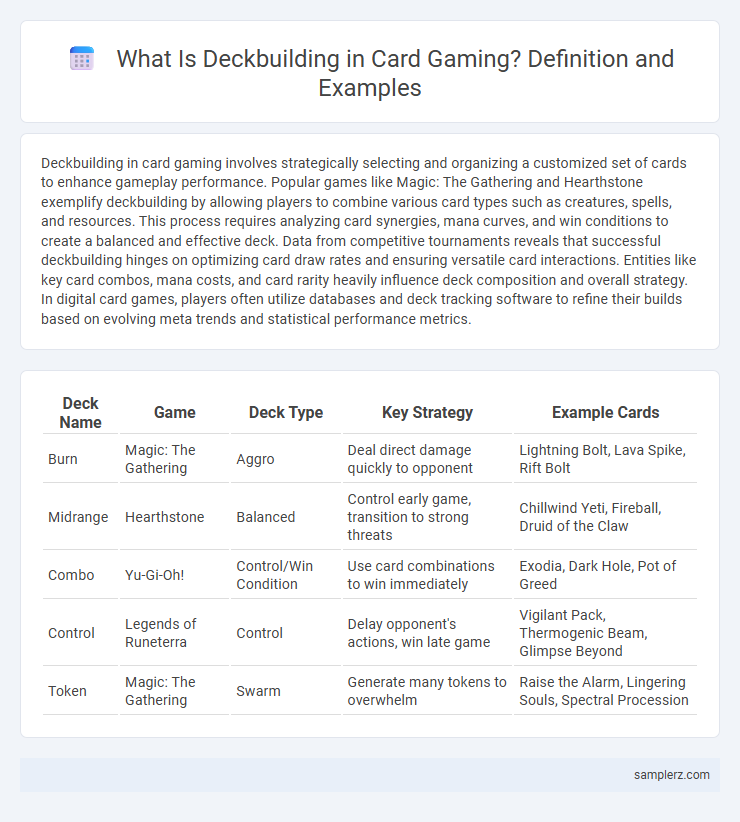Deckbuilding in card gaming involves strategically selecting and organizing a customized set of cards to enhance gameplay performance. Popular games like Magic: The Gathering and Hearthstone exemplify deckbuilding by allowing players to combine various card types such as creatures, spells, and resources. This process requires analyzing card synergies, mana curves, and win conditions to create a balanced and effective deck. Data from competitive tournaments reveals that successful deckbuilding hinges on optimizing card draw rates and ensuring versatile card interactions. Entities like key card combos, mana costs, and card rarity heavily influence deck composition and overall strategy. In digital card games, players often utilize databases and deck tracking software to refine their builds based on evolving meta trends and statistical performance metrics.
Table of Comparison
| Deck Name | Game | Deck Type | Key Strategy | Example Cards |
|---|---|---|---|---|
| Burn | Magic: The Gathering | Aggro | Deal direct damage quickly to opponent | Lightning Bolt, Lava Spike, Rift Bolt |
| Midrange | Hearthstone | Balanced | Control early game, transition to strong threats | Chillwind Yeti, Fireball, Druid of the Claw |
| Combo | Yu-Gi-Oh! | Control/Win Condition | Use card combinations to win immediately | Exodia, Dark Hole, Pot of Greed |
| Control | Legends of Runeterra | Control | Delay opponent's actions, win late game | Vigilant Pack, Thermogenic Beam, Glimpse Beyond |
| Token | Magic: The Gathering | Swarm | Generate many tokens to overwhelm | Raise the Alarm, Lingering Souls, Spectral Procession |
What Is Deckbuilding in Card Games?
Deckbuilding in card games involves strategically selecting and organizing a personalized set of cards to maximize synergy, resource management, and tactical advantage during gameplay. Players construct decks by combining various card types, such as creatures, spells, and equipment, to create powerful combinations that counter opponents' strategies. Mastery of deckbuilding requires understanding card interactions, game mechanics, and adapting to meta shifts to optimize win rates in competitive environments.
Key Principles of Effective Deckbuilding
Effective deckbuilding in card gaming centers on maintaining a balanced mana curve to ensure smooth resource management throughout gameplay. Prioritizing synergy among card abilities maximizes strategic potential, enabling powerful combinations that disrupt opponents. Including a mix of removal, threats, and defensive cards enhances versatility, adapting to diverse in-game scenarios and opponent strategies.
Popular Deck Archetypes Explained
Popular deck archetypes in card gaming include Aggro, Control, and Midrange, each with distinct strategies. Aggro decks focus on fast-paced damage to overwhelm opponents quickly, while Control decks prioritize board control and resource management to outlast adversaries. Midrange decks blend aggression and control, adapting flexibly to opponents' moves for balanced gameplay.
Example: Aggro Deck Construction
Aggro deck construction in card gaming prioritizes low-cost, high-damage cards to quickly overwhelm opponents, often including efficient creatures and direct damage spells. Key cards typically feature aggressive stats and synergy to maintain early board control and pressure. Effective aggro decks balance speed and resource management to dominate the early stages of the game before opponents stabilize.
Example: Control Deck Strategy
Control deck strategy in card games emphasizes managing the board by countering threats and removing opponents' cards while gradually gaining card advantage. Core cards often include counterspells, board clears, and card draw mechanics to maintain control throughout the game. This approach relies on patience and resource management to dominate late-game scenarios and secure victory.
Example: Combo Deck Synergies
Combo deck synergies in card gaming focus on strategically combining cards that interact to create powerful effects, such as infinite damage loops or unstoppable board control. A classic example is the "Splinter Twin" deck in Magic: The Gathering, which pairs Splinter Twin with Deceiver Exarch or Pestermite to generate infinite creature tokens and overwhelm opponents. These synergies rely on precise card interactions and timing to maximize game-winning potential.
Example: Midrange Deck Balance
Midrange deck balance in card gaming strategically combines early-game control cards with powerful mid-to-late game threats, ensuring consistent pressure throughout the match. Effective deckbuilding involves selecting versatile creatures, efficient removal spells, and adaptive resource generators to maintain tempo and board presence. Key examples include balancing low-cost minions like 2-drop creatures with high-impact finishers such as 5 to 7-mana cards.
Deckbuilding in Digital Card Games
Deckbuilding in digital card games involves strategically selecting cards to create a balanced and synergistic deck that maximizes winning potential. Popular titles like Hearthstone and Magic: The Gathering Arena allow players to customize decks by combining different card classes, spells, and creatures to counter opponents effectively. Efficient deckbuilding requires understanding card mechanics, mana curves, and meta-game trends to optimize performance in competitive play.
Essential Cards for Successful Decks
Essential cards in successful deckbuilding often include a balanced mix of low-cost mana cards, versatile removal spells, and synergy-driven creatures that complement the deck's primary strategy. Key staples like "Lightning Bolt" for direct damage, "Counterspell" for disruption, and "Mulldrifter" for card draw consistently enhance deck efficiency and control. Prioritizing cards that offer multiple utility phases or can shift roles depending on the game state maximizes overall deck performance and adaptability.
Tips for Improving Your Deckbuilding Skills
Analyzing card synergy and balancing offense with defense are crucial tips for improving your deckbuilding skills in gaming. Prioritize including cards that complement each other's abilities and maintain a consistent mana curve to ensure smooth gameplay. Testing and refining your deck through practice matches helps identify weak spots and optimize overall performance.

example of deckbuilding in card Infographic
 samplerz.com
samplerz.com